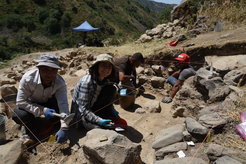Life at the Crossroads: Land use, connectivity, state formation, and resilience in ancient Armenia
Situated at the intersection of the Near East, Europe, and the Caucasus, Armenia has long been a meeting point for diverse cultures and populations. This region provides a unique opportunity to examine how societies responded to environmental shifts, economic developments, and political transformations over time. Through a cross-disciplinary analysis of cultural and biological materials from archaeological sites across modern Armenia, our research explores the complex interplay between historical, socioeconomic, political, and climatic factors in shaping human lifeways, social organization, and land use practices.
Trade and Subsistence Economies in Chalcolithic Armenia (TrAnSEC Armenia)

The Chalcolithic (Copper Age) in the South Caucasus (ca. 5500/5200–3500 BCE) marked a period of significant technological and socio-economic transformations, defined by the development of mining techniques, extractive copper metallurgy, and increased cultural contact and exchange. Scholars have argued that during the Chalcolithic the Caucasus underwent a shift toward greater mobility, driven by the exploitation of highland resources, facilitating connections with Mesopotamia, Iran, Anatolia, and the North Caucasus. While mobile pastoralism is often cited as the key driver of these interactions, questions remain about the diversity of land use strategies, forms of subsistence, and settlement patterns in highland environments.
TrAnSEC Armenia addresses these questions through the archaeological exploration of Southern Armenia and the excavation of Yeghegis-1 Rockshelter. By integrating biomolecular methods with traditional archaeological techniques, this project reassesses long-held views on pastoral mobility, animal exploitation, and human-environment interactions during this pivotal period.
Towards State Formation: Urban and Economic Foundations of the Urartian Kingdom
Urartu, the first kingdom to emerge in the Armenian Highlands, developed rapidly in the mid-9th century BCE, reaching its peak in the 8th and 7th centuries BCE. Characterized by cuneiform inscriptions, advanced metallurgy, standardized measurement systems, and distinctive architecture, Urartu became a dominant power in the Near East, frequently warring with Assyria. However, continuous conflicts weakened the kingdom, leading to its decline in the early 6th century BCE.
This project aims to shed light on urban life, socio-economic structures, resource management, and human-environment interactions prior to and during the Urartian period. Through archaeological and biomolecular analyses—including stable isotope and paleoproteomic studies of human and animal remains—our research focuses on three sites from the Urartian period: the Erebuni and Karmir Blur fortresses, as well as the Lori Berd necropolis, which was occupied since the late 3rd millennium BCE. The comparative analyses of these sites will allow us to gain insights into the complex interplay of power, commodity extraction, food resource management and social systems within an urban-commercial civilization.
Surviving Change: Human Lifeways in the Changing Geopolitical Landscape of Medieval Armenia
The Medieval period saw profound geopolitical transformations, including the establishment of the Armenian Kingdom, the Mongol invasions, the emergence of the Ottoman Empire, and Persian Safavid rule, each leaving an indelible mark on the society, economy, and culture of the Armenian Highlands. We aim to investigate how the interplays of historical, social, political, economic, and climatic changes have influenced human lifeways, social organization, and land use practices via an osteological and stable isotope analysis of the humans and fauna of different Medieval sites located across modern Armenia.
By constructing biological profiles of human remains, we aim to assess both individual health and collective population dynamics. Utilizing stable and radiogenic isotope analysis we will reconstruct dietary patterns from early childhood to adulthood, exploring variations in food consumption that may reflect local adaptations or broader socio-political influences. Through this multidisciplinary approach, we seek to provide new insights into how Medieval Armenian communities navigated shifting political landscapes.











